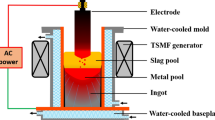Abstract
The grain structure and macrosegregation directly affect the mechanical properties of electroslag remelting (ESR) ingots which are important raw materials in industry. In this paper, an axisymmetric multiscale multicomponent transient model based on cellular automaton-finite element (CAFE) method is developed by coupling macroscopic phenomena (including fluid flow, heat and solute transfer) and the mesoscopic structure evolution (e.g. nucleation and grain growth) to predict grain structure and macrosegregation. The solutions of the mass, momentum, energy, solute conservation equations and grain growth kinetics are calculated simultaneously. The single grain information (e.g., the size, shape and aspect ratio) is obtained by minimal oriented bounding box (MOBB) method and statistically analyzed. Firstly, the accuracy of this multiscale mathematical model is validated by comparing grain structures and solute concentration profile from simulation with those from experiments. Secondly, the effects of two processing factors, the melting rate and heat transfer coefficient, on the grain structure and macrosegregation are investigated. When the melting rate increases from 12.7 to 25.5 g/s, the maximum positive segregation index of carbon increases from 4.5 pct to 9 pct and the average grain size decreases from 120.0 to 21.0 mm2. When the heat transfer coefficient increases from 250 to 500 W/(m2 K), the maximum positive segregation index of carbon decreases from 5.6 pct to 3.7 pct and the average grain size increases from 44.6 to 76.8 mm2. Finally, the coupling effect of grain growth and macroscopic fields including fluid flow and macrosegregation is analyzed. When the fluid flow is decoupled from grain growth, the predicted angle between the columnar grain and the ingot axis is 4.85 deg larger than that of fully coupled case and the predicted average length of columnar grain becomes smaller. When the macrosegregation is ignored in the ESR process, the predicted depth of liquid pool decreases by 2.0 mm, and the equiaxed grain zone at the center of the ESR ingot becomes small. This multiscale transient model using CAFE method could be able to set processing parameters for the desired products with adequate accuracy.



















Similar content being viewed by others
References
A. Kharicha, E. Karimi-sibaki, M. Wu, A. Ludwig, and J. Bohacek: Steel Res. Int., 2018, vol. 89, p. 1700100.
B. Hernandez-Marales and A. Mitchell: Ironmak. Steelmak., 1999, vol. 26, pp. 423–38.
Q. Chen and H. Shen: Metals., 2019, vol. 9, p. 177.
Q. Wang, H. Yan, F. Wang, and B. Li: JOM., 2015, vol. 67, pp. 1821–9.
A. Ludwig, M. Wu, and A. Kharicha: Metall. Mater. Trans. A., 2015, vol. 46A, pp. 4854–67.
Q. Wang, H. Yan, N. Ren, and B. Li: Appl. Therm. Eng., 2016, vol. 101, pp. 564–7.
Q. Wang, H. Yan, N. Ren, and B. Li: JOM., 2016, vol. 68, pp. 397–400.
L. Nastac, S. Sundarraj, K.O. Yu, and Y. Pang: JOM., 1998, vol. 50, pp. 30–5.
L. Nastac: Metall. Mater. Trans. B., 2014, vol. 45B, pp. 44–50.
B. Li, F. Wang, and H. Zhang: J. Iron Steel Res., 2011, pp. 159–65.
B. Li, Q. Wang, F. Wang, and M. Chen: JOM., 2014, vol. 66, pp. 1153–65.
X. Wang and Y. Li: Metall. Mater. Trans. B., 2015, vol. 46B, pp. 800–12.
S.D. Ridder, F.C. Reyes, S. Chakravorty, R. Mehrabian, J.D. Nauman, J.H. Chen, and H.J. Klein: Metall. Trans. B., 1978, vol. 9, pp. 415–25.
S.D. Ridder, S. Kou, and R. Mehrabian: Metall. Trans. B., 1981, vol. 12, pp. 435–47.
K. Fezi, J. Yanke, and M.J.M. Krane: Metall. Mater. Trans. B., 2015, vol. 46B, pp. 766–79.
Q. Wang, Z. He, G. Li, and B. Li: Appl. Therm. Eng., 2016, vol. 103, pp. 419–27.
C.A. Gandin and M. Rappaz: Acta Metall. Mater., 1994, vol. 42, pp. 2233–46.
C.A. Gandin, G. Guillemot, B. Appolaire, and N.T. Niane: Mater. Sci. Eng. A., 2003, vol. 342, pp. 44–50.
G. Guillemot, C.A. Gandin, and H. Combeau: ISIJ Int., 2006, vol. 46, pp. 880–95.
W.S. Ping, L.D. Rong, G.J. Jie, L.C. Yun, S.Y. Qing, and F.H. Zhi: Mater. Sci. Eng. A., 2006, vol. 426, pp. 240–9.
W.D. Bennon and F.P. Incropera: Int. J. Heat Mass Transf., 1987, vol. 30, pp. 2161–70.
N. Ahmad, J. Rappaz, J.L. Desbiolles, T. Jalanti, M. Rappaz, H. Combeau, G. Lesoult, and C. Stomp: Metall. Mater. Trans. A., 1998, vol. 29A, pp. 617–30.
C.A. Gandin, J.L. Desbiolles, M. Rappaz, and P. Thevoz: Metall. Mater. Trans. A., 1999, vol. 30A, pp. 3153–65.
M. Rappaz and C.A. Gandin: Acta Metall. Mater., 1993, vol. 41, pp. 345–60.
J. Lipton, M.E. Glicksman, and W. Kurz: Mater. Sci. Eng., 1984, vol. 65, pp. 57–63.
L. Qing: Acta Metall. Sin., 2017, vol. 53, pp. 494–504.
J. Yu, F. Liu, Z. Jiang, C. Kang, K. Chen, H. Li, and X. Geng: Steel Res. Int., 2018, vol. 89, p. 1700481.
J. O’Rourke: Int. J. Comput. Inf. Sci., 1985, vol. 14, pp. 183–99.
R. Alhajj and J. Rokne, eds.: Encyclopedia of Social Network Analysis and Mining, Springer, New York, 2014, pp. 641–641.
R.L. Graham: Inf. Process. Lett., 1972, vol. 1, pp. 132–3.
Q. Wang: Doctor of Philosophy, Northeastern University, 2016.
Acknowledgments
This work was financially supported by the National Natural Science Foundation of China, Grant Number 51875307.
Author information
Authors and Affiliations
Corresponding author
Additional information
Publisher's Note
Springer Nature remains neutral with regard to jurisdictional claims in published maps and institutional affiliations.
Manuscript submitted April 22, 2021; accepted October 2, 2021.
Rights and permissions
About this article
Cite this article
Shi, H., Chen, Q., Li, K. et al. Numerical Simulation of Grain Structure and Macrosegregation of Electroslag Remelting Process Based on Cellular Automaton-Finite Element Method. Metall Mater Trans B 53, 107–120 (2022). https://doi.org/10.1007/s11663-021-02346-9
Received:
Accepted:
Published:
Issue Date:
DOI: https://doi.org/10.1007/s11663-021-02346-9




